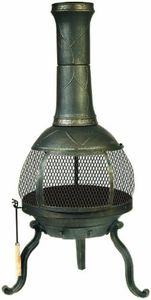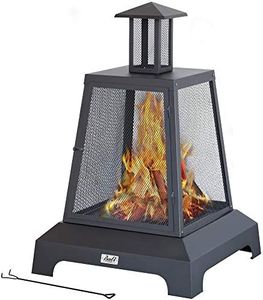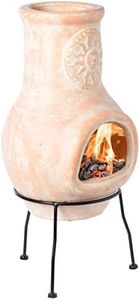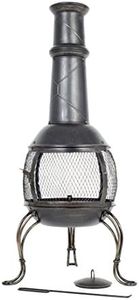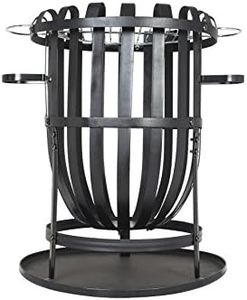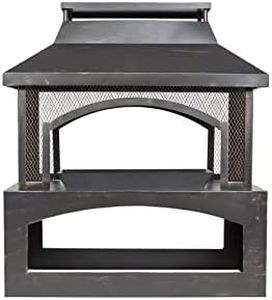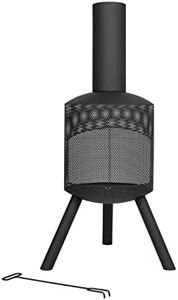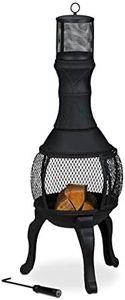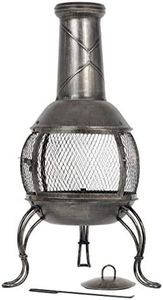We Use CookiesWe use cookies to enhance the security, performance,
functionality and for analytical and promotional activities. By continuing to browse this site you
are agreeing to our privacy policy
10 Best chimineas
From leading brands and best sellers available on the web.Buying Guide for the Best chimineas
Choosing the right chiminea can be a great way to enhance your outdoor space, providing warmth and a cozy atmosphere for gatherings or relaxation. To find the best fit for your needs, it's important to look beyond appearance and understand the key features that influence safety, ease of use, durability, and overall satisfaction. Before purchasing, consider where you'll place it, what you'll use it for most, and how much effort you’re willing to give for care and maintenance. Let’s look at some essential things to think about as you make your decision.MaterialThe material of a chiminea is crucial because it affects heat retention, durability, weight, and the style of maintenance needed. The most common materials are clay, cast iron, and steel. Clay chimineas have a rustic charm and provide gentle, even heat but are more fragile and can crack if not cared for properly. Cast iron options are very sturdy and hold heat well for long-lasting warmth, but they’re heavy and can rust if not maintained. Steel chimineas are lighter and often more affordable; they heat quickly but cool down faster and may also be prone to rust. Your lifestyle and where you plan to put the chiminea can help you decide: if you want something authentic and are able to take care of it, clay is great; for maximum durability, choose cast iron; if you’ll be moving it around or want something low-maintenance, steel is a good pick.
SizeSize refers to the overall dimensions of the chiminea, including its height and the width of its fire chamber. This is important because it affects how much heat the chiminea gives off, how much space it takes up, and how much fuel it can hold. Smaller chimineas (under 3 feet tall) work well for intimate patios or decks and for smaller gatherings, offering enough warmth for a couple of people nearby. Medium sizes (about 3–4 feet) suit family use and average backyards. Larger chimineas (over 4 feet) are meant for bigger spaces and groups, giving off more heat but also needing more room and more fuel. Choose the size based on your outdoor space and how many people you want to keep warm.
Fuel TypeFuel type is about what the chiminea burns: typically wood, charcoal, or gas. This matters because each fuel gives a different heating experience, varying in ambience, convenience, and maintenance. Wood-burning chimineas deliver a classic, crackling fire with smoky aroma, but need more cleanup and some skill in fire-starting. Charcoal is easy to use and burns longer with less smoke but doesn't produce quite the same warmth or atmosphere as wood. Gas chimineas offer instant heat with minimal mess—just turn them on and off—but lack the charm of a real fire. Decide which is right for you by thinking about whether you value convenience, ambience, or a bit of both.
Ventilation and Safety FeaturesVentilation refers to how the chiminea is designed to let air flow in and out, which affects how well it burns and how safe it is to use. Good ventilation means fires light easily and burn cleanly, reducing smoke and the risk of sudden flare-ups. Look for chimineas with wide front openings and sometimes a vent or chimney top that helps direct smoke away from people. Some models also have safety features like spark screens to keep hot embers inside or sturdy bases to prevent tipping. Your user needs matter here—if you have kids or plan to use the chiminea in a small or covered area, make ventilation and safety especially high priorities.
Maintenance RequirementsMaintenance requirements cover how much effort you'll need to keep your chiminea in good shape over time—cleaning out ash, protecting from bad weather, and dealing with rust or cracks. Clay chimineas should be covered and protected from rain or frost, while metal ones might need regular brushing and protective coatings to prevent rust. Some chimineas need to be moved indoors in extreme weather, while others are designed to stay outside year-round. Your willingness and ability to do regular maintenance, as well as your local weather patterns, will point you to the right choice for your situation.
Style and AestheticsStyle and aesthetics refer to the look and feel of the chiminea, including its color, shape, and decorative details. While this might not affect performance directly, it’s important if your outdoor area has a certain look you want to keep. Traditional clay chimineas often have hand-painted designs for a rustic feel, while metal ones can be sleek, modern, or industrial. Match your chiminea to your taste and the overall vibe of your outdoor space for the most satisfying addition.
